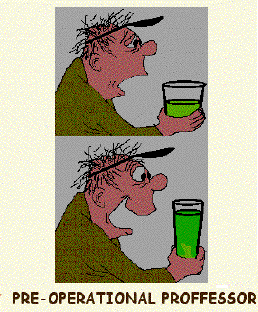NOTES:
The Vygotsky Piaget - - great thinkers with opposing views
NOTES:
Piaget and his theory of cognitive development.
NOTES:
Vygotsky and his Theory of Learning.
Piaget: Concepts before words; and Egocentric Speech before Social Speech
Researchers from Europe traditionally followed a Gestaltist mode of research, observing behavior and then describing it. In my mind Piaget was the consummate Gestaltist. His observations and conclusions are widely studied throughout the educational community.
Originally, Piaget was a biologist. He patiently observed many mollusks for hours and meticulously noted their behavior, and then suddenly realized that it matched the behavior of some of the teenagers sitting around the house. Woops, come to think of it, it was my dad, not Piaget who said that, Dad was a professional pest control exterminator, and was commenting on the behavior of slugs. Sorry about that Piaget!
But Piaget did observe many children to provide us with some valuable insights into their cognitive and language development. No course on Language Development can pass muster without some notes on Piaget's observations.
Piaget's description of the development of the thought processes is interesting to me because of its implications to language development. He describes how cognition begins at birth in an autistic state, and then progresses toward an intellectual state.
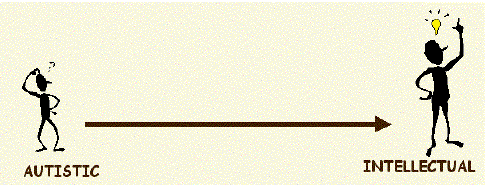
The name "Autistic," here does not refer to the disability of Autism, but instead to a time of life when consciousness is totally centered on the self, with no awareness or interest in the events of the outside world.
The mechanism of growth is called Adaptation. It is composed of two elements. Assimilation and Accommodation. This can all be conceptualized using the model of a ladder.
Assimilation is analogous to each wrung. It's the way we perceive the world, given the level of development of our neurological infra-structure at the time. At birth we are on the bottom wrung and everyone's structure is pretty much the same. It is a networkof basic reflexes.
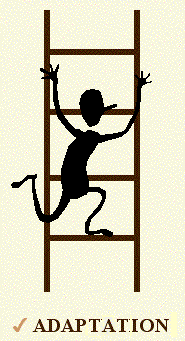
The infant's network of basic reflexes determines both motor behavior and sensory input. A touch on the cheek for the infant, for example, is perceived as a food stimulus, and the rooting reflex will be initiated in response.
It makes no difference what the source of the touch is--a bottle, a finger or a tongue blade etc. To a baby, it is all food (assimilation).
Two things will change that perception. They both contribute to the growth of the neural infra-structure.
One is the normal growth due to natural maturational development.
The other involves connections developed as a consequence of experiences.
These experiences center around a need that arises to change a behavior to return the body system to a state of balance. The state of imbalance may be that the baby is hungry.
A touch on the cheek with the finger does not bring satisfaction. A touch from the nipple of a bottle full of mother's milk does.
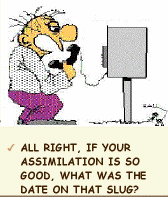
Accommodation: Eventually the child after he/she has experienced the finger with its disappointing results, will learn to discriminate between a finger and a nipple. This change is accommodation. It represents neural growth. Accommodation, then is going from one wrung of the ladder to the next.
And then a new view of the world is possible (assimilation).
The baby accepts any bottle until one day someone puts pink medicine in it that smells and looks different, and tastes bad! The baby now has a need to discriminate colors and smell. After doing so, (accommodation again) she/he will no longer accept bottles filled with pink, which are preceived as unsatisfying (assimilation).
Each experience, is like the "tick" of a clock, which marks off the progression of the child's development along the continuum of cognitive growth.
One can see that having needs to solve, and being able to solve them is a healthy process for cognitive growth.
Of course, needs that are traumatic and/or unsolvable are destructive and to be avoided if possible. More desirable are needs to learn how to manipulate toys etc.
Whatever the experiences are, the more -ticks... that occur, the faster and farther the child will develop cognitively.
The child's progression along this continuum is somewhat mirrored, according to Piaget, in the context communications which involve either of two kinds of speech--Egocentric and Social
Of course, in the original state of cognition (Autistic) thoughts can not be represented linguistically. Obviously there is no language available at birth.
But to me, even after language has developed, there appear to be personal thoughts which cannot be put into language. This is the eternal draw of the other forms of symbolization such as music, art and dance etc.
By the age of two, however, speech has begun to emerge. Now there becomes a bridge into the mind of the child.
This speech bridge becomes a portal through which we can observe cognitive growth. This period represents Syncretistic thought processes.
Syncretistic thought processes carry much of the quality of autistic thought. Obviously at this point there is more interest in the environment.
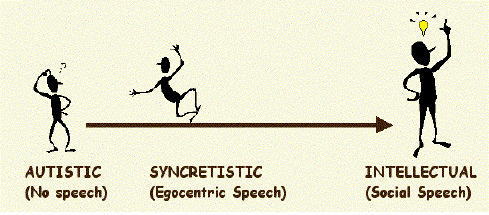
But the hallmark of the egocentric stage is the "centeredness" of one's consciousness. The egocentric mind is the center of all things. What it wants, everyone wants. What it feels, everyone feels. What it sees, everyone sees. What it knows everyone knows, and so forth.

Another good example is that of a four year old child who wanted to be in the room with the adults after bedtime. Five minutes after the mom said goodnight, the child came creeping into the living room with his hands over his eyes.
In his egocentric thought processes, he concluded that if he couldn't see the adults, they couldn't see him.
That reminds me that I used to listen to a radio broadcast called the "Shadow" in which an adult made the same assumption. He was lucky he didn't get killed.
Syncretistic thought produces what Piaget calls Egocentric Speech. In egocentric speech, since the child is the center of the universe, the assumption is that people will understand what is said no matter how it is said, because "what the child knows, everyone knows."
Hence, in egocentric speech there is no effort made to tailor the speech so that it can be understood by a particular listener.
In many instances also, since syncretistic thought is self centered, the speech is not even an effort to communicate but is made for the pure enjoyment of the speaker. There are three kinds of Egocentric Speech: Echolalia, Monologues and Social (or Dual) Monologues.
Echolalia is repeating sounds, words, phrases and/or sentences for the fun of saying it. Adults do it occasionally when they are bored or scared.
A Monologue is a running discourse. It usually occurs when a child is playing. Often it is just fragments of sentences that can be heard (see the notes).
The Collective (Dual or Social) Monologue involves usually two or more children playing in close proximity. They may be playing different games and they may be commenting on them and they may be even taking turns in vocalizing, but the context of their speech is not correlated between each other.
Children do it all the time when their playing, teenagers do it when they are rapping, and adults do it, especially when they have been drinking.
In the notes you can hear an example of teenagers doing it. This is a short excerpt from the TV series (one of the few worthwhile ones) called "My So Called Life."
One teen is talking about a teacher who misused his name, and the other is talking about a girl who asked him to help her with Algebra.
Social Speech: Piaget notes that the incidence of Egocentric Speech slowly dies out between 2 and 7 years as that of Social Speech increases. Social is a reflection of Intellectual thought processes in which the attention is focused on the environment. The intent of Social Speech is to communicate with the environment and to interact with it. Hence, unlike egocentric speech, steps are taken to make the communication as successful as possible. This includes a consideration of all the parameters of language from phonemes to pragmatics. I was reminded of this once while I was in the waiting room of a Dr.'s Office when a woman of Chinese ancestry came in with her little three year old bilingual daughter.
After a short while her daughter came over to speak to me.
The first thing that impressed me about the little girl is that she first assessed my cultural background and selected her English Code (pragmatics) to speak to me.
In that code she selected the words that expressed her thought (semantics) and put them in the proper syntax (grammar); and with clearly enunciated speech sounds (phonemics) she said, "Can I have my doll?"
It was a verbalization with a clear intent to communicate a message and I immediately complied. Now, if you are wondering why I had her doll, that is an anecdote for the final chapter of another class including a condensed discussion of Freudian Psychology as interpreted by Speech Professors, entitled Freud in a Nut Shell.
Piaget suggests that an indication of mental maturity can be gained by computing a ratio of the incidences of Egocentric to Social Speech.
To understand what happens next, one must consider how Vygtsky viewed language. Before language, the child had two developing skills: speech (a motor act) and thought (a non verbal process of problem solving).
Speech without thought (A) was just a motor act. An example would be a child repeating the phrase, "Sing a song of six pence, a pocket full of rye."
Thought without words (B) would be reflected by a child who pulled a chair over to assist with an intended ascent to a forbidden cupboard.
Verbal Thought (C) is forged when speech becomes internalized. It interfaces with the thought processes to create a new kind of thinking--verbal thought which is called language. We still retain, however the ability for speech without thought, for example, "Hey diddle diddle, the cat and the fiddle, the cow jumped over the moon"
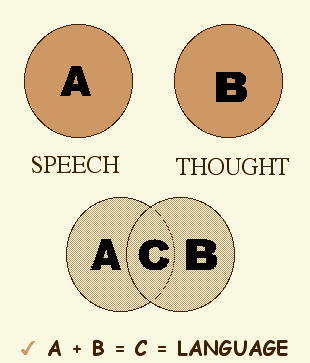 On the other hand some of our greatest thinkers, such as Einstein and Hawking, describe how they visualized the structure of the universe in non verbal models and then only after that described them with numbers and words.
On the other hand some of our greatest thinkers, such as Einstein and Hawking, describe how they visualized the structure of the universe in non verbal models and then only after that described them with numbers and words.
So how and when does this merger of thought and speech occur?
The child, before the advent of language is prone to be an individual who responds directly to stimuli.
When he is hungry he wants to eat now. If he is angry, he will cry and strike out. If he wants something, he will take it (if he can), etc.
During this time, speech like other cognitive and motor skills is steadily developing. We are talking here between two and seven years of age.
Quickly, parents are using speech to control the child's behavior. "Come here, Edward," they say, or "Put your shoes on."
Whether this acts as a model, or whether it's a genetic trait, the child begins to control his/her own behavior using speech.
Like all motor skills that are newly learned, it has to be physically acted out. Hence the child speaks out loud.
If you watch children play, for example, you will often hear them give a running discourse of what they are doing. An example is in the notes.
This discourse is the egocentric speech that Piaget was describing. They are speaking their movements. "Now I'm going in the house," a child might say referring to a playhouse. "Now I'm feeding the baby."
As the child becomes more adept at controlling their behavior verbally, the need to physically act out the speech act diminishes, as verbal imagery takes it's place. Hence the quality of the egocentric speech likewise diminishes.
This was described by Piaget, you remember, as a dying out of egocentric speech as the thought processes mature.
To Vygotsky, however, egocentric speech was the internalization of speech to become a verbal way of thinking--called language.
But there was one more twist to account for the apparent degeneration of egocentric speech.
Vygotsky explains that we don't think with a full-blown sentence structure. That would be too cumbersome. Hence, we create our own personal verbal short-hand for our thinking processes. But when someone says, -A penny for your thoughts,... we rush to create the full context which we will use to communicate.
The creation of the verbal short hand begins as the child is internalizing speech to become verbal thought.
This short hand is actually reflected in the egocentric speech of the child and hence, makes it appear to be disintegrating.
If Vgotsky is correct about speech being internalized to become a major part of the verbal thought process, then the quality of that speech becomes even more critical.
For children entering kindergarten, if their speech is rich in vocabulary and grammatical nuances, their verbal thought processes will be best equipped to capitalize on what school has to offer. These children will typically enjoy school and have the best chances of succeeding. But if their speech lacks these assets at the time it is internalized, these children will be unable to grasp the full meaning of stories, instructions and much of the teaching materials.
But there is another problem also. We talked earlier about how the nonlinguistic child responds directly to stimuli. This is action without inhibition.
Children (or adults) without language simply act on the urge of the moment. Hence, Edward without language would immediately take the dolly he wants because he wants it.
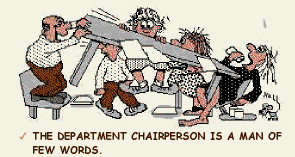 (Any resemblences in the picture above, to persons living or dead within the Department of Communication Disorders & Sciences is purely a Fruedian psychololgical phenomenon)
When language is acquired, it becomes an intermediate step that can delay and/or change the response.
Hence,Edward with language may still want the doll but will think to himself linguistically, "The doll does not belong to me.Teacher has said that it is wrong to take some thing that does not belong to me."
Then he would probably take the doll anyway, but it would take him a little longer to commit the crime than it would have without language. And who knows, he may even feel some guilt. The point is, that non verbal kids are impulsive and hard to control in and out of the classroom.
My conclusion then, from what Vygotsky has theorized, is that we need to be as aggressive as we know how in our strategies to facilitate the development of speech during these formative years, before the internalization process concludes.
(Any resemblences in the picture above, to persons living or dead within the Department of Communication Disorders & Sciences is purely a Fruedian psychololgical phenomenon)
When language is acquired, it becomes an intermediate step that can delay and/or change the response.
Hence,Edward with language may still want the doll but will think to himself linguistically, "The doll does not belong to me.Teacher has said that it is wrong to take some thing that does not belong to me."
Then he would probably take the doll anyway, but it would take him a little longer to commit the crime than it would have without language. And who knows, he may even feel some guilt. The point is, that non verbal kids are impulsive and hard to control in and out of the classroom.
My conclusion then, from what Vygotsky has theorized, is that we need to be as aggressive as we know how in our strategies to facilitate the development of speech during these formative years, before the internalization process concludes.
So who is right, Piaget or Vygotsky? I don't think that it has to be an either-or situation with these theories.
Frankly, I can think of a third use for egocentric speech, which I have observed in two and three year old children.
That is, speech for practice. I have heard children repeating certain vocabulary and/or grammatical phrases which they have recently learned.
I have even heard young children practicing substituting different words into a grammatical structure. The child might say, "Wash the baby; wash the dolly; wash the dog; wash the frog; wash the bird;" etc. This verbal play serves the same purpose, I believe, as practicing shooting baskets achieves for a basketball player.
Hence, I believe that on some occasions, the child may be exhibiting egocentric speech for practice purposes as I described.
At other times it is a phenomenon generated by the syncretistic thought processes, as Piaget conceives of it.
And still at other times, egocentric speech may be the "tip of the iceberg" providing us with a fleeting glimpse of speech being internalized to become verbal thought as Vygotsky suggests.
Speaking of the thought processes, there is another major difference between Piaget and Vygotsky. Piaget stresses that concepts must be developed first, before speech can be mapped on to it to attain meaning.
Vygotsky suggested that speech can be used to create concepts.
Simply stated Piaget stresses concept development before speech. Vygotsky urges the use of speech to develop concepts. Again, I don't believe it is an either or situation. Both aspects deserve our consideration and research suggests the child does both simultaneously.
Piaget describes four qualitatively different periods or stages of intellectual growth, which we pass through.
According to Piaget these stages can not be skipped, although some researchers disagree with this.
But Piaget does say that the time schedule for passing through the stages can be facilitated by experience.
Piaget also notes that there is no guarantee that an individual will pass through all of the stages. In most cases (not all) it takes formal instruction in high school and college to break into the highest stage.
I do know a grandmother, however, who never finished the 6th grade. She reads vehemently, nevertheless, and has a vast reserve of concepts which helps her to see the world in as many dimensions as a college graduate.
Piaget's four stages of intellectual development are:
- SENSORY-MOTOR
- PRE-OPERATIONAL
- CONCRETE OPERATIONS
- FORMAL OPERATIONS
Sensory-Motor Stage (0 - 2 years): This is analogous to Kephart's Motor Stage. It is a non-linguistic time of life, but it is a mighty busy time as the child prepares for the advent of language.
During this period very many basic concepts about the world are acquired; and indeed, some in particular are essential to the development of language.
Four particularly critical concepts include the concept of self; cause and effect; and object permanence; and symbolic behavior.
1. Self-Concept: One of the first major concepts that must be developed is the understanding of ourselves as discrete individuals separated from the world. Three activities come to my mind to facilitate this development. They are the three M's: message, movement and mirrors.
Message: Much touching and rubbing of the child's legs and arms and back, etc. is going to hasten the development of a body map in the child's brain. This will help to increase his/her awareness of body limits.
Movement: Encouraging the baby to get down on the floor and explore and thrash and roll and crawl and manipulate objects will hasten the development of a body motor map in the child's brain.
Mirrors: Having mirrors available for young infants (and older) to see themselves is also a excellent practice. Visual feedback is helpful for the development of any motor skill, but when the child finally recognizes themselves in the mirror, they have attained a special level of awareness reached by few living creatures--recognition of self! This is a wonderful phenomenon for a partent to observe.
2. Cause and Effect: Much of what language is, is a description of cause and effect. The structure of English reflects this. Someone (the noun phrase) has caused something to happen to someone else (the verb phrase--kernel sentence type II). Hence, the understanding of cause and effect is critical to language use and understanding.
The best way I can see to facilitate the concept of cause and effect is to optimize opportunities for interactions with the environment.
The first big lesson can be started when the child is very young, like from 30 seconds to a year.
Every baby will have some basic needs and will communicate them orally, often at 3:00 in the morning.
In my opinion, no matter what time of day or night it is, we want to respond to the baby's crying! We want the baby to experience the fact that vocalization (the cause) brings an effect (comfort).
Yes, it is more convenient for parents if the child can be quickly molded to their schedule; but raising babies for the convenience of the parents is not the way to raise babies with good feelings about communication.
Granted, after one year, many smart babies begin to use crying with wily intent and parents have to use their discretion to maintain their autonomy.
The more interactions the child has with the parents and other extended family, the more the role of cause and effect in our lives can be demonstrated to the child.
It would seem here also that the more objects the child is allowed to come in contact with (toys in particular) the more opportunity there will be for the infant (child) to explore the phenomenon of cause and effect. The toys don't have to be elaborate or expensive to be effective!
They may be just household objects, like just a piece of cloth or a blanket, which the child will turn into a myriad of make-believe toys. Of course, parents must monitor the flow of these objects so the child is not inundated with them all at once.
These interactions with people, objects are literally the child's tools of the trade for developing language.
The more tools children have for learning in these first two years, the better students of concept and language development they will be.
3. Object Permanence: A symbol is not a call to action. It is a call to bring information about something into the mind.
More often, that something is not present at the time, or may not even exist (like Santa Clause).
This all rests on the basic concept of "Object Permanence"--the understanding that something can exist even if it is not in our presence.
Piaget's classic example is an infant who wants an object, like a bottle or keys.
If the keys are put within the infant's reach so he can get them, all is fine. But if the bottle is put in the infant's reach in a manner such that it is masked (like under a pillow) one of two things may happen.
The infant will either simply just cry; or the infant will pursue the bottle under the pillow. In the former case, the infant is demonstrating a lack of the concept of object permanence. For him the bottle has gone. In the latter case, the infant retains the image of the bottle and knows it still exists under the pillow even if he can't see it; and wanting it, he goes after it.
This demonstrates an awareness of object permanence.
. . . AND. . .
You can make the task less difficult for the child who can't retain the image by partially hiding the bottle.
You can make it more difficult to challenge the infant who has made headway with the concept by hiding it under two or more pillows and later by switching the pillows around like the old "shell game."
Imitation is both a sign of imagery (object permanence) and a tool to develop it.
Piaget notes that imitation is the outward manifestation of imagery. Encouraging the child to imitate exercises those neural process for imagery.
Patty-Cake and Peek-a-boo are also excellent activities for very young infants to facilitate the development of object permanence. Endless variants of these games can be created.
4. Symbolic Behavior: This is more of a process than it is a concept. It is, nevertheless, an important activity that we look for and try to facilitate in the first two years. Playing games in which an object represents something else is the name of the game here. It is interesting that you might buy a child an expensive elaborate toy house, only to find them playing house in an old carboard box. But the box becomes a symbol for a house; and a peice of wood a symbol for a bed; and so on. In the child's developing mind, the symbolic processes cry to be exercised and find their expression in playtime.
The Pre-Operational Stage (2- 7 years): Piaget has much to say about this second stage. For our purposes we will zero in on the fact that it is the time of life when the child climbs on to the Linguistic Band Wagon. It is a window of opportunity that does not stay open permanently. As the child approaches puberty, if he/she has not gained some form of language, the ability to do so ends!
There is a slogan that sticks out in my mind about this period.
It is, "A Child Should Be Seen and Not Heard." What a disastrous concept. Can you imagine how well we would learn archery if we were taught by being told to watch only, but not to practice it?
Of course, children, being the language geniuses that they are could do it. But that is in spite of us. How much better they can do with our help! And how do we help during this period?
The key is adult to child dialogue! Parents who talk to their children a lot and encourage them to respond verbally will have children with advanced speech skills; and hence advanced language skills; an hence advanced thought processes. The reason is quite obvious. When parent talk to their children, they provide rich models for all the language rules we have discusses: phonology, morphology, syntax and pragmatics. They even provide special help in the way of using motherese talk (using short sentences with special prosody) as described in the text.
They repeat and slightly rephrase or extend what the child has said, thus providing the best models for the child's language acquisition device, to coin a phrase of Chomsky's.
Hence, the child might say, "Daddy come." Mother might then say, "Daddy's coming," a rephrase, or "You see Daddy coming," a slight extension.
This intense adult-child interaction will make the language processes seem to grow significantly by the day.
As always, the other BIG GUN for developing language is READING to the child. Again, the vocabulary and syntax contained I books is richer than included in oral dialogues. The child may wish to read the same books many times and this is good for the reasons we discussed under eidetic imagery.
The child will have more time to extract the linguistic principles; and will develop expectancies which will improve his/her listening skills. This will improve their enjoyment which will increase their motivation to use language.
Concrete Operations Stage (7 - 11 years): One hallmark of this stage is the concept of Conservation. Up to this time, in the Pre-Operational Stage, the parents had it easy with the Kids. For example, if you poured a child a glass of juice and it wasn't enough to suit him, you simply poured the contents into a narrower but taller glass. This usually satisfied the need for more.
This worked because at the pre-operational stage the child is barely able to abstract one bond, which in my example is the height.
